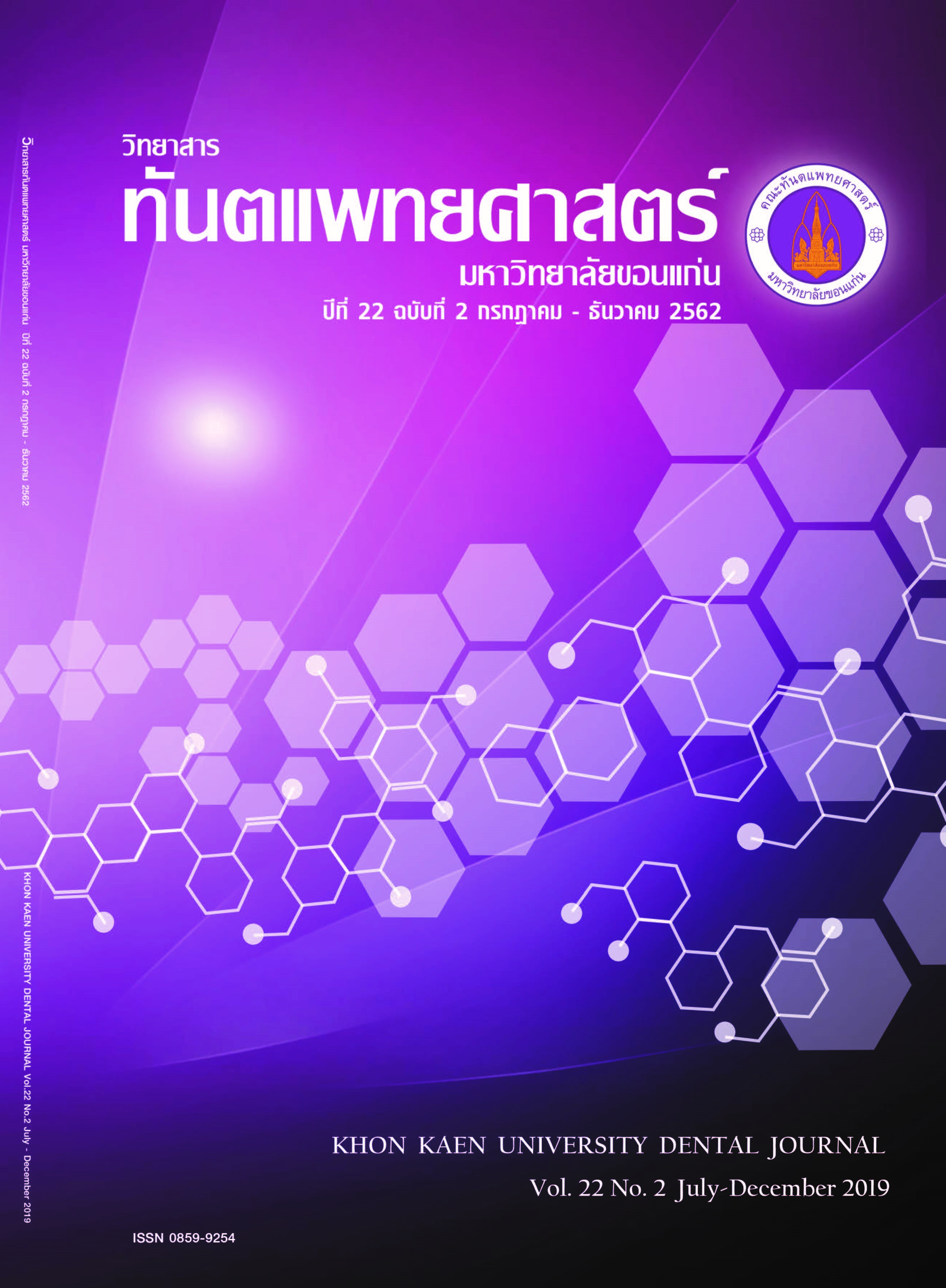Lightweight Opened Hollow Bulb Obturator Using a Precise Positioning Method of Metal Framework in Patients with Partial Maxillectomy: a Case Report A clinical report
Main Article Content
Abstract
Successes of using an obturator in rehabilitation for a maxillectomy patient depend on size and location of defect. Large maxillary defects with a few remaining abutments located in a relatively straight line lead to a decrease in support, stability, and retention of prostheses due to unfavorable leverage. To minimize this leverage, weight reduction of a prosthesis should be considered. In this clinical report, a patient with a large hemimaxillectomy defect was rehabilitated with a one-piece opened hollow bulb obturator using a cast metal framework. A special tray with opening access was used for making a functional impression of the defect site to obtain a precise working cast. Afterwards, the cast was modified at the defect site to simulate the contour of normal ridge using a mixture of plaster and pumice in order to properly position the meshwork. These procedures, including the predetermined reduction of acrylic thickness, resulted in a lightweight obturator with improvement of stability, retention, and function.
Article Details
บทความ ข้อมูล เนื้อหา รูปภาพ ฯลฯ ที่ได้รับการลงตีพิมพ์ในวิทยาสารทันตแพทยศาสตร์ มหาวิทยาลัยขอนแก่นถือเป็นลิขสิทธิ์เฉพาะของคณะทันตแพทยศาสตร์ มหาวิทยาลัยขอนแก่น หากบุคคลหรือหน่วยงานใดต้องการนำทั้งหมดหรือส่วนหนึ่งส่วนใดไปเผยแพร่ต่อหรือเพื่อกระทำการใด ๆ จะต้องได้รับอนุญาตเป็นลายลักษณ์อักษร จากคณะทันตแพทยศาสตร์ มหาวิทยาลัยขอนแก่นก่อนเท่านั้น
References
Spiro RH, Strong EW, Shah JP. Maxillectomy and its classification. Head Neck 1997;19(4):309-14.
Omo J, Sede M, Enabulele J. Prosthetic rehabilitation of patients with maxillary defects in a nigerian tertiary hospital. Ann Med Health Sci Res 2014;4(4):630-3.
Murat S, Gurbuz A, Isayev A, Dokmez B, Cetin U. Enhanced retention of a maxillofacial prosthetic obturator using precision attachments: two case reports. Eur J Dent 2012;6:212-17.
Patil PG, Patil SP. A hollow definitive obturator fabrication technique for management of partial maxillectomy. J Adv Prosthodont 2012;4(4):248-53.
Cardelli P, Bigelli E, Vertucci V, Balestra F, Montani M, Carli SD, et al. Palatal obturators in patients after maxillectomy. Oral Implantol (Rome) 2014;7(3):86-92.
Lyons KM, Beumer J 3rd, Caputo AA. Abutment load transfer by removable partial denture obturator frameworks in different acquired maxillary defects. J Prosthet Dent 2005;94(3):281-8.
Aramany MA. Basic principles of obturator design for partially edentulous patients. Part II: Design principles. J Prosthet Dent 1978;40:656-62.
Wu YL, Schaaf NG. Comparison of weight reduction in different designs of solid and hollow obturator prostheses. J Prosthet Dent 1989;62(2):214-7.
Keyf F. Obturator prostheses for hemimaxillectomy patients. J Oral Rehabil 2001;28(9):821-9.
Shrestha B, Hughes ER, Singh RK, Suwal P, Parajuli PK, Sherestha P, et al. Fabrication of Closed Hollow Bulb Obturator Using Thermoplastic Resin Material. Case Rep. Dent 2015; 504561
MA A. Basic principles of obturator design for partially edentulous patients. Part I: Classification. J Prosthet Dent 1978;40(5):554-7.
Oh WS, Roumanas E. Alternate technique for fabrication of a custom impression tray for definitive obturator construction. J Prosthet Dent 2006;95(6):473-5.


